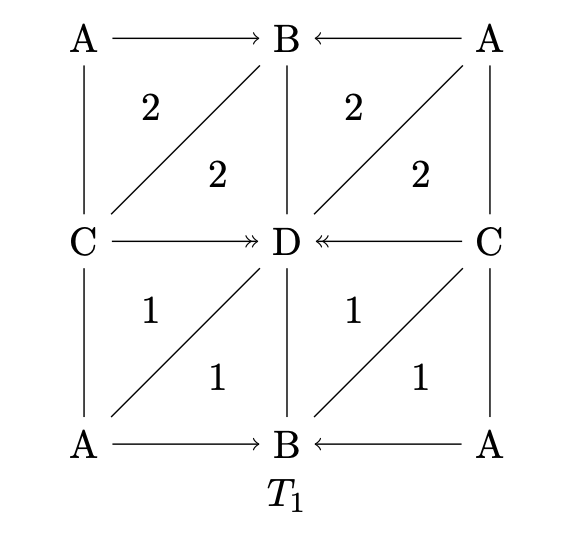My question is the following:
Are there triangulations of $S^3$ which (a) are non-degenerate, (b) have four vertices, and (c) have no edges of degree two?
A side question:
If one represents this triangulation as a graph, and draws it's dual graph, is it true that it is a planar graph?
(At the moment I'm unable to construct a planar graph starting from an edge degree 6 or 8 with the above requirements and taking into account the comments , that all degrees are even, as I end up with growing number of tetrahedra.)
Here are the definitions.
We use labeled triangulations of $S^3$. We allow adjacent tetrahedra to share multiple faces. The degree of a vertex (or an edge) is the number of tetrahedra connected to it, counted with multiplicity.
We only allow non-degenerate triangulations. That is, we require that every edge is embedded (meets two vertices). Note that this implies that all triangles and tetrahedra are embedded.
However, we do not require our triangulations to be simplicial (where a cell is determined by its vertices). In particular, we allow many edges to share the same two endpoints as vertices. In this case we distinguish the edges by their labels. The same applies to triangles and tetrahedra.
There are various moves that can change the configuration to another. To be concrete, imagine two adjacent tetrahedra defined by vertices $\{a, b, c, d\}$ sharing four faces. Note that all edges have degree two. Let's call this our "initial configuration". We can add additional tetrahedra to the initial configuration (maintaining the topology) in various ways.
0-2 face move: Choose a triangle (between two tetrahedra $A$ and $B$) and glue in a pair of tetrahedra ($C$ and $D$) sharing three faces, (and a new vertex: $e$), and their remaining face is glued between let's say the triangle $(a b c)$ and its copy $(a,b,c)$, defining the set now as: $\{a b c d\}$, $\{a b c d\}$, $\{a b c e\}$, $\{a b c e\}$. This is like inflating a triangle into a sphere and putting a vertex in the middle. The same vertices can define unique triangles and edges. If we would give labels to triangle $(a b c)$ or the other $(a b c)$ they would differ due to their adjacency relation. This move increases the number of vertices.
1-4 move: Choose a tetrahedron. Add a vertex in the middle of the tetrahedron, connecting it to all the four vertices, splitting the interior into 4 tetrahedra.
2-3 move Choose a face meeting distinct tetrahedra. Add an edge to connect the distant vertices of two adjacent tetrahedra, exchanging a triangular face with an edge. This turns two tetrahedra into three.
0-2 edge move: Choose two adjacent triangles $(a b c)$, $(a b d)$, and open them up, inserting two tetrahedra $\{a b c d\}$ and $\{a b c d\}$, by creating a copy of $(a b c)$ and $(a b d)$ in the process. The move adds two tetrahedra, a new edge with degree 2, and splits the original [a b] edge into be two with smaller or equal degree than their original. (0-2 edge move)
One could devise other type of moves, adding extra edges, adding/ removing extra vertices, to change the triangulation into another one. (Note that all moves can be obtained from the bistellar flips: the 2-3 and 1-4 moves.)








